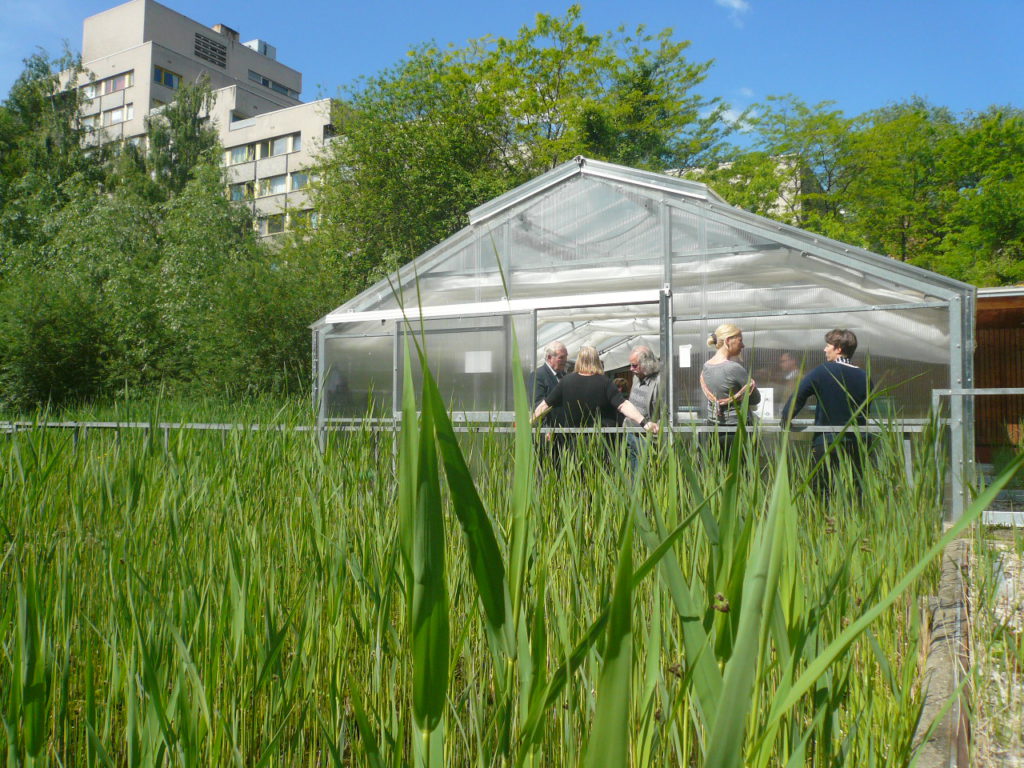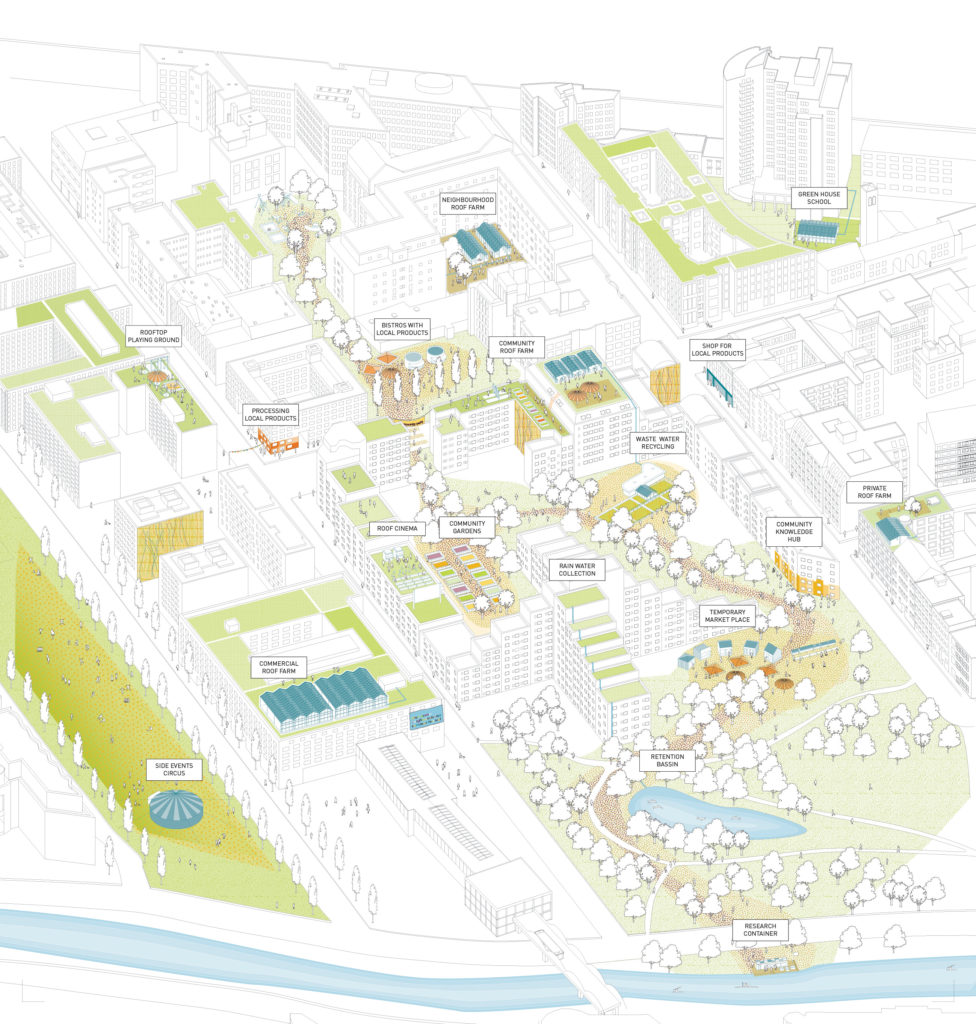Ways to upcycle water and waste in buildings
February 14, 2022
In line with our ongoing student competition FuturArc Prize (FAP) 2022: Reinterpretation, we are highlighting projects that follow the theme.
Submit your entries by 25 February 2022!
An important tenet of sustainability is to make good use of what already exists. This means reusing existing buildings instead of demolishing them (which is energy-intensive and emits a large amount of carbon to the atmosphere), and on top of that, to upcycle things that are usually considered as excesses or waste. This could include sunlight, rainwater run-off, kitchen waste, discarded materials and so on.
Here, we present several ideas to reuse water and kitchen waste that can be applied across many typologies.
Roof Water-Farm
An ongoing cooperative research project, ROOF WATER-FARM (RWF) features the combined installation of water recycling technology and building-integrated farming. The focus of this blue-green infrastructure approach is on the reuse of daily water resource flows combined with lightweight water farming such as aquaponics (combined fish and plant farming) and hydroponics (soil-less plant farming such as using nutrient film techniques or NFT).
The project’s test site sits in the historic neighbourhood of the International Building Exhibition (IBA) in 1987 in Kreuzberg, near the former Berlin Wall and today’s Potsdamer Platz. This site has been also a model project of the Experimental Housing and Urban Development (EXWOST) research programme until 2000. Since then, this Berlin inner-city neighbourhood has become an ongoing laboratory.
The project is a showcase of ecological responsibility by its blue-green design philosophy that is practised through:
• the safe and high-quality upcycling of waste water into service water for toilet flushing, household water and irrigation purposes;
• local fertiliser production out of the daily waste/resource flows;
• building-integrated water farming for urban fish and vegetation food production;
• active climate change mitigation through decentralised rainwater management that enhances evaporative plant-driven cooling processes in an urban wetland providing biodiversity and economic benefits.
RWF advocates social accountability via a participatory approach that has resulted in multiple benefits:
• the local community of 250 people, connected to the local water treatment plant, benefits from lower service water prices as well as aesthetically pleasing open spaces and blue-green landscape atmosphere;
• the local community as well as local and international visitors are part of the RWF network by being involved with workshops, guided tours and harvest festivals;
• it is an ongoing real laboratory for diverse groups of people, especially focusing on applied learning and education of students and trainees.
The current and ongoing challenge is to establish applied follow-up projects within real estate developments. This process of upscaling and transferring the positive research results requires a broad and transdisciplinary support of the public authorities involved—from food and water safety departments to the planning and approval stages. Furthermore, it needs additional and direct funding for blue-green project entrepreneurs who could catalyse this kind of climate- and resource-friendly urban development.
Originally published in FuturArc 1Q 2020 issue. Subscribe to the digital edition or hardcopy to read the complete article!
The Sustainable Kitchen
Eating healthy and sustainably is starting to shape the food industry worldwide. Aside from catering to our changing diets, new establishments are also looking at ways they can be designed to reduce waste and their carbon footprint.
After all, sustainability is not just about where food is sourced but also about how the restaurant is designed and operates. Ovens burn heat, dishwashers and lights consume energy and both the production and disposal of food require an abundance of energy and resources. Add in the materials required to build these establishments and you have even more design considerations to take into account when catering to both our appetites and the planet.
So what is a sustainable kitchen and what does it mean to design for health and sustainability?
Designing for a sustainable food industry that is well suited to both the clientele and the chef’s culinary tastes is nothing short of a challenge. As patrons look for restaurants that are more sustainable, providing transparency in the food supply chain is often key. This has led to a market of restaurants tailoring to more farm-to-table dining and menus catered to more specific food diets.
With it also comes a shift in kitchen design. For example, kitchens with selective gluten-free or vegan food options will most often require separate counter space to limit cross contamination. In-house production using raw materials and the preservation of food (i.e. curing, fermentation and pickling) often requires additional equipment, appliances or storage.
Some other new design considerations include the incorporation of rooftop gardens, green walls and even small farms. As we get further away from our agricultural roots, connecting our food with elements of nature helps to affirm the concept of farm-to-table dining and bring the message home. However, while these concepts may seem rather modest, there are also many design specifications and trade-offs to consider. For one, designers may be required to choose between incorporating energy-efficient lighting or artificial lighting that is more energy-intensive but supports plant growth. Rooftops may need to be assessed by an engineer for their load-bearing capacity before a garden can be built, while on-site conversion of food scraps into fertilisers may require some knowledge of permaculture principles.
An example of a is Café 27, flagship in Beijing, China. The restaurant was completely redeveloped from a greenhouse. Equally inspired by the choice of food, the architects retrofitted the space into an inside-out garden pavilion where patrons could escape from the city’s polluted air. Combined with terrazzo flooring, a green wall, a wood trellis that shades the glass structure, and a garden that extends to the exterior, the thermal mass and diffusion of light create a thermally comfortable environment indoors. Believing that nothing speaks healthy food like a healthy environment, the use of ecologically sound devices and Green architecture helped the architects heighten the client’s high standards for fresh, quality organic ingredients.
Originally published in FuturArc July-August 2017 issue. To read the magazine in full, order it from our shop!
A hawker centre in Singapore generates energy and bio-fertiliser
Composting kitchen waste may be par for the course—but this hawker centre takes it further by installing on-site processing facility that can generate energy.
At East Coast Lagoon Food Village, an anaerobic digestion system has been piloted for food waste treatment. This aims to reduce the incineration of food waste, which would release the highest amount of CO2 emissions to the atmosphere. The system will generate electricity and produce bio-fertiliser to improve the surrounding park infrastructure.
An anaerobic digestion system takes in digestible food waste, such as fruits and vegetable trimmings, preparation scraps from the stalls and leftover table waste. Microbes then feed on the blended food waste to produce methane-rich biogas and nutrient-rich liquid digestate.
The biogas is then used to run a gas engine to generate electricity, which is able to power the system itself and two mobile phone charging stations for the public’s use. The excess electricity can also power up to 31 wall-mounted fans at East Coast Lagoon Food Village. As for the digestate, NUS is working with the National Parks Board to study its efficacy for growing ornamental plants and turn it into pathogen-free fertilisers for landscaping application around East Coast Park.
In 2020, food waste accounted for about 11 per cent of the total waste generated in Singapore, but only 19 per cent was recycled. This waste can contaminate other recyclables when they are disposed of together, making the recyclables unsuitable or difficult to recycle. It can also give rise to odour nuisance and vermin proliferation issues, if not managed properly or in a timely manner. Considering the hazard as well as the potentials, there is ample opportunity for food waste to be managed holistically.
Designers of places where a high volume of food waste is expected—such as food courts, canteens, and even residences—should consider to adopt on-site waste treatment systems to close the loop from its source. There is also the opportunity to use recycled materials in their installation. For example, the concrete base that supports the anaerobic digestion system in this food village is made from NEWSand, a by-product from the slagging gasification of general waste. If more broadly adopted, these strategies will help to reduce waste sent to landfills.
How would you apply circular strategies into a Green hub for public good? Submit your ideas to FAP by 25 February 2022 and win cash prizes!

To read the complete article, get your hardcopy at our online shop/newsstands/major bookstores; subscribe to FuturArc or download the FuturArc App to read the issues.
Previously Published Commentary, Online Exclusive Feature
Contact us at https://www.futurarc.com/contact-us for older commentaries.


